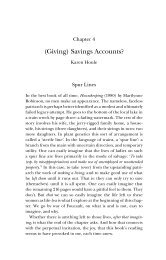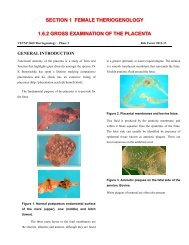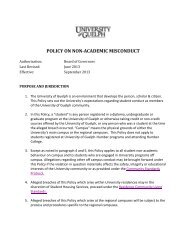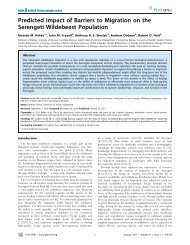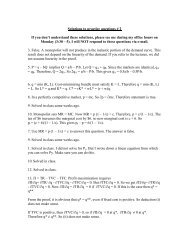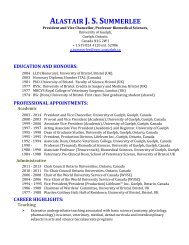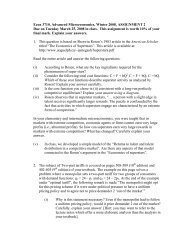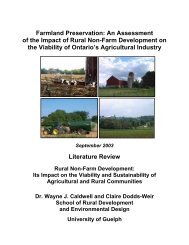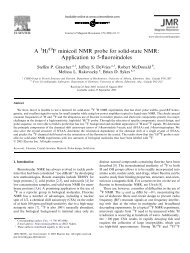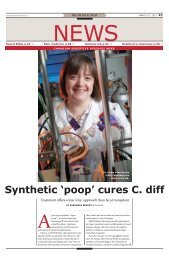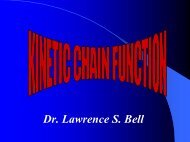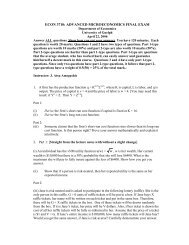Research Symposium - University of Guelph
Research Symposium - University of Guelph
Research Symposium - University of Guelph
Create successful ePaper yourself
Turn your PDF publications into a flip-book with our unique Google optimized e-Paper software.
<strong>Research</strong><br />
<strong>Symposium</strong><br />
Ontario Veterinary College,<br />
Pathobiology/AHL Building, Room 1800<br />
April 27 th , 2011<br />
9:25am – 5:00pm<br />
Photo: Kimberly Sheppard<br />
Photo: Kristi Bovey<br />
1<br />
Photo: Marisa Erasmus
Thank you to our Sponsor:<br />
ORAL PRESENTATIONS<br />
9:25 Welcome<br />
Session I - Management and environment: How can we do better?<br />
9:30 Lighting source and the development <strong>of</strong> feather pecking in a commercial turkey<br />
facility<br />
Graham Duggan, Lloyd Weber, Tina Widowski, Stephanie Torrey*<br />
9:50 An initial study <strong>of</strong> daily activity time budgets in captive giraffes with reference to<br />
potential welfare issues<br />
Denise Lukacs*, Stephen Miller, Jim Atkinson, Esther Finegan<br />
10:10 Measuring cow comfort on commercial dairy farms in Canada<br />
Clémence Nash*, Jessica Zaffino, Jenny Gibbons, Elsa Vasseur, Derek Haley<br />
10:30 Keynote I - Stuart Little is drowning!<br />
H. Davis<br />
11:10 Break & Poster Session<br />
Session II - Feeding for optimal welfare: How, what, where and when?<br />
11:40 The effect <strong>of</strong> different diets and dietary regimes on feather coverage in broiler<br />
breeder hens<br />
Krysta Morrissey*, Tina M. Widowski, Steve Leeson, Vicky Sandilands, Hank Classen,<br />
Stephanie Torrey<br />
12:00 Separating the stressors: a pilot study investigating the effect <strong>of</strong> a graduated<br />
weaning practice on behaviour and performance <strong>of</strong> dairy calves<br />
Amy Stanton*, Raymond Brooks, Patrick Gorden, Bruce Leuschen, James West, David<br />
Kelton, Rebecca Parsons, Tina Widowski, Suzanne Millman<br />
12:40 Free-access feeding <strong>of</strong> acidified milk replacer – effects on calf performance, health<br />
and welfare<br />
Cynthia Todd*, Trevor DeVries, Kenneth Leslie, Jan Sargeant, Neil Anderson, Suzanne<br />
Millman<br />
1
1:00 LUNCH<br />
Session III - Assessing and treating pain and injury<br />
2:00 Objective assessment <strong>of</strong> pain in dairy cattle with clinical mastitis<br />
Colleen Fitzpatrick*, Núria Chapinal, Todd Duffield, David Kelton, Trevor DeVries, Christina<br />
Petersson-Wolfe, Ken Leslie<br />
2:20 Do therapeutic ho<strong>of</strong> blocks alter dairy cattle behaviour?<br />
Janet Higginson*, Jan Shearer, David Kelton, Pat Gorden, Gerard Cramer, Anne Marie de<br />
Passille, Suzanne Millman<br />
2:40 The effect <strong>of</strong> ketopr<strong>of</strong>en following left displaced abomasum surgery on lying<br />
behaviour and ketosis<br />
Nathalie Newby*, Stephen LeBlanc, Ken Leslie, David Pearl, Marina von Keyserlingk, Todd<br />
Duffield<br />
3:00 I’m not going there! Using conditioned place preference to assess the aversiveness<br />
<strong>of</strong> restraint and blood sampling in piglets<br />
Puja Wahi*, Stephanie Yue Cottee, Tina Widowski<br />
3:20 Break & Poster Session<br />
3:50 Keynote II - On-farm intervention to improve management practices affecting<br />
dairy calf and heifer welfare: Development <strong>of</strong> an advisory tool<br />
Elsa Vasseur*, Anne Marie de Passillé, Jeff Rushen, Daniel Lefebvre, Doris<br />
Pellerin<br />
4:30 Wrap-up and Student prizes<br />
POSTER PRESENTATIONS<br />
Brain lesions and time to death resulting from non-penetrating captive bolt application for<br />
euthanasia <strong>of</strong> piglets up to 9 kg<br />
Teresa Casey-Trott*, Raymond Brooks, Patricia Turner, Stephanie Nykamp, Marcus Litman,<br />
Suzanne M Millman, Tina Widowski<br />
The effects <strong>of</strong> frequency <strong>of</strong> feed provision on the feeding behaviour <strong>of</strong> limit-fed dairy<br />
heifers<br />
Angela Greter*, Todd Duffield, Brian McBride, Tina Widowski, Trevor DeVries<br />
Effect <strong>of</strong> milk feeding level on performance and feeding behaviour <strong>of</strong> dairy calves<br />
Emily Miller-Cushon, Renee Bergeron, Ken Leslie, Trevor DeVries<br />
2
Challenges and successes <strong>of</strong> Ontario animal shelters: Maximizing resources to impact<br />
shelter dog welfare<br />
Amanda McKibbon, Tina Widowski, Stephanie Yue Cottee<br />
“Please pass the Prozac” exploring the use <strong>of</strong> pharmacologic agents for studying negative<br />
emotional states in hens<br />
Stephanie Yue Cottee, Kenner Rice, Tina Widowski<br />
3
ABSTRACTS<br />
Keynote Presentations<br />
Speaker #1: Hank Davis<br />
Stuart Little is Drowning!<br />
Hank Davis<br />
<strong>University</strong> <strong>of</strong> <strong>Guelph</strong>, Department <strong>of</strong> Psychology, <strong>Guelph</strong>, ON, Canada<br />
Mice are everywhere: we know them as adorable images on greeting cards, children’s books and<br />
movies; as welcome participants in biomedical research; and as unwelcome visitors in our<br />
homes. We are ambivalent about them, to say the least. I will examine just how deeply that<br />
ambivalence runs, and suggest that perhaps we should channel some <strong>of</strong> our affection for mice<br />
named Mickey and Stuart Little into our treatment <strong>of</strong> the unwanted specimens we meet. It’s time<br />
to decide whether this highly successful small mammal is a friend or a foe <strong>of</strong> humanity, and start<br />
treating them accordingly.<br />
Speaker #2: Elsa Vasseur<br />
On-farm Intervention to Improve Management Practices Affecting Dairy Calf and Heifer<br />
Welfare: Development <strong>of</strong> an Advisory Tool<br />
Elsa Vasseur 1 2 , Anne Marie de Passillé 1 , Jeff Rushen 1 , Daniel Lefebvre 3 , and Doris Pellerin 2<br />
1 Pacific Agri-Food <strong>Research</strong> Centre, Agriculture and Agri-Food Canada, Agassiz, British<br />
Columbia, Canada; 2 Animal Sciences Department, Laval <strong>University</strong>, Quebec, Quebec, Canada; 3<br />
Valacta, Dairy Production Centre <strong>of</strong> Expertise Quebec-Atlantic, Sainte-Anne-de-Bellevue,<br />
Quebec, Canada<br />
Mortality and morbidity <strong>of</strong> dairy calves remain high in North America, which is a costly animal<br />
welfare concern. A survey <strong>of</strong> 115 Quebec dairy farms found mean perinatal calf mortality <strong>of</strong> 9.3<br />
%, which producers underestimated by 40 %. Most producers felt calf mortality was not a problem<br />
on their farm. There is a need for interventions at the farm level to help producers improve calf<br />
welfare, production sustainability and consumer assurance. From this survey, we identified 9<br />
areas <strong>of</strong> concern related to calf and heifer health and welfare: calving management, care <strong>of</strong> the<br />
newborn and painful procedures, colostrum management, weaning, calf feeding, calf housing,<br />
heifer feeding, heifer housing, and health. We developed an advisory tool to identify the critical<br />
points where management impacts the welfare <strong>of</strong> calves and heifers. We recommended targets<br />
for each area <strong>of</strong> concern and provided background explanation for those targets. For example,<br />
the area <strong>of</strong> concern “colostrum management” had many targets such as “first feeding <strong>of</strong> colostrum<br />
within first 4 h <strong>of</strong> calf’s life”. An expert committee validated the scoring system and<br />
recommendations. The tool was tested in 28 Quebec dairy farms for feasibility, producer<br />
satisfaction and repeatability. Farmers were asked to take colostrum and blood samples, and<br />
record health data. The on-farm evaluation included an interview on management practices and<br />
in-barn measurements related to calf and heifer welfare. The efficiency and usefulness <strong>of</strong> the tool<br />
was evaluated by the producers during a final debriefing. We found that we could keep farm visits<br />
4
elow 3 h and that we had good repeatability <strong>of</strong> our qualitative environment-based variables<br />
(Kappa value>0.6). Our advisory tool was useful in detecting critical points and to discuss them<br />
with the producers. For some targets, producers scored on average below 50 % (on a scale from<br />
0 %, target not reached to 100 %, target reached) in calving management, care to newborn<br />
calves and painful procedures, colostrum management, and calf feeding. Six months after the onfarm<br />
visit, producers had implemented some recommended practices. For example, a first<br />
feeding <strong>of</strong> colostrum within first 4 h <strong>of</strong> calf’s life was done by 75 % <strong>of</strong> producers (vs. only 39 %<br />
before the visit). Identifying welfare risk factors in management is essential to construct an onfarm<br />
welfare advisory tool adapted to a target population. Voluntary improvements in calf welfare<br />
were facilitated by using our tool to educate producers and help them change their calf<br />
management practices.<br />
5
Oral Presentations<br />
Separating the stressors: a pilot study investigating the effect <strong>of</strong> premixing on behavior<br />
and performance <strong>of</strong> dairy calves<br />
Amy L. Stanton 1 *, Raymond A. Brooks 2 , Patrick J. Gorden 2 , Bruce L. Leuschen 2 , James K. West 2 ,<br />
David F. Kelton 1 , Rebecca L. Parsons 2 , Tina M. Widowski 1 , Suzanne T. Millman 2<br />
1<br />
Departments <strong>of</strong> Population Medicine and Animal and Poultry Science, <strong>University</strong> <strong>of</strong> <strong>Guelph</strong>,<br />
<strong>Guelph</strong>, ON, Canada; 2 Iowa State <strong>University</strong>, Ames, IA, USA<br />
The majority <strong>of</strong> milk-fed calves in North America are individually housed and the transition to<br />
group housing following weaning can be stressful and result in increased susceptibility to disease.<br />
The objective for this research was to determine the effect <strong>of</strong> separating the stressors <strong>of</strong> postweaning<br />
mixing and movement to a novel environment. The hypothesis was that mixing calves in<br />
a nursery prior to moving would reduce the stress associated with these changes as<br />
demonstrated by increased feed intake and decreased activity during the post-movement period.<br />
Weaned calves were randomly assigned to either a pre-mixed or traditionally raised treatment. At<br />
enrolment calves were 49 ± 9 (mean ± standard deviation) days <strong>of</strong> age. Pre-mixed calves (8<br />
groups <strong>of</strong> 4 calves) were grouped in the nursery barn by removing dividers between pens on Day<br />
0 to form a single large pen in which they remained for 1 week (Day 7). Traditional calves (8<br />
groups <strong>of</strong> 4 calves) remained individually housed until Day 7. On Day 7, all calves were moved to<br />
a new barn where they were grouped by treatment in pens <strong>of</strong> 4 calves. Calves were weighed on<br />
Days -1, 6, and 13. Grain intake was measured at the group level on Day 3 through Day 12. On<br />
Day -4 an accelerometer (IceTag®) was attached to the mid-metatarsal region. Daily averages<br />
for activity and calf starter intake were calculated for baseline (Day -1 and -2), mixing (Day 0-6)<br />
and post-movement (Day 7-13) periods. Associations between treatment, behavior, starter intake<br />
and average daily gain (ADG) were analyzed using linear mixed models. Calf starter intake was<br />
not significantly different between treatments during mixing or post-movement periods (P=0.34<br />
and 0.55, respectively). Pre-mixed calves tended to gain more during the mixing period than the<br />
traditional calves (0.9±0.5 kg, P=0.10). There was no difference in weight gain during the postmovement<br />
period between treatments (P=0.73). Treatment had no effect on the number <strong>of</strong> lying<br />
bouts during mixing and post-move periods (P=0.11 and 0.47, respectively). During the postmovement<br />
period, pre-mixed calves tended to rest longer (P=0.09) and take (327±204) fewer<br />
steps per day than traditional calves (P=0.10) Pre-mixing calves tended to increase ADG premixing<br />
and reduce activity changes associated with movement to a novel environment. This<br />
indicates that pre-mixing may reduce the stress associated with movement to a novel<br />
environment.<br />
Environment and the development <strong>of</strong> feather pecking in a commercial turkey facility<br />
Graham Duggan 1 , Lloyd Weber 2 , Tina Widowski 1 and Stephanie Torrey 1,3 *<br />
1 Department <strong>of</strong> Animal and Poultry Science, <strong>University</strong> <strong>of</strong> <strong>Guelph</strong>, <strong>Guelph</strong>, ON, Canada; 2 LEL<br />
Farms, <strong>Guelph</strong>, ON; 3 Agriculture and Agri-Food Canada, <strong>Guelph</strong>, ON, Canada<br />
Feather pecking is a serious welfare concern for the poultry industry. While inroads have been<br />
made into understanding the causal factors involved in feather pecking in the laying hen, little<br />
research has been done to examine the problem in the domestic turkey. Environment appears to<br />
6
play an integral role in feather pecking, although the relationship between environment and<br />
pecking has never been examined in commercial housing. The objective <strong>of</strong> this pilot study was to<br />
examine the development <strong>of</strong> feather pecking in two environments in a commercial turkey tom<br />
facility, with the expectation that higher light intensities would induce more feather pecking. After<br />
rearing in identical pens, 49,332 beak-trimmed male turkeys were placed in two growing facilities<br />
at 4.5 weeks <strong>of</strong> age: environmentally controlled (artificial light and ventilation; E) or curtain-sided<br />
(natural light and ventilation; C) environment (5000-7500 turkeys/pen; n=8 pens) through 15<br />
weeks <strong>of</strong> age. Video-recordings captured feather pecking behaviour, feather condition was scored<br />
on 4 body regions (neck, back, wing and tail) and weights were measured on a randomly-selected<br />
100 birds/pen every 3 weeks. Mortalities and culls were recorded as they occurred. Data were<br />
analyzed with a mixed-model analysis, with repeated measures used where applicable. Mortality<br />
and behaviour data were log and square-root transformed, respectively. Light intensity in E<br />
ranged from 1-338 Lux. C barns experienced intensities ranging from 150-4800 Lux. We found a<br />
difference (P=0.01) in severe feather pecking between the two environments, with 2.8 times as<br />
many pecking bouts occurring in C as in E. There was no difference in gentle feather pecking<br />
(P=0.84). Feather scores were different between the two environments (P=0.007), with C having<br />
worse plumage than E throughout the experiment. Culls and mortality were also influenced by<br />
environment (P=0.002). In E, 3.2% <strong>of</strong> turkeys were culled or died, with 1.1% <strong>of</strong> culls and deaths<br />
due to pecking. In C, 6.5% <strong>of</strong> turkeys were culled or died, with 4.4% <strong>of</strong> culls and deaths due to<br />
pecking. Growth rates did not differ between environments. In conclusion, the lack <strong>of</strong> control over<br />
the environment in a commercial setting was detrimental to turkey welfare by leading to increased<br />
feather pecking and resulting injuries and deaths.<br />
Objective Assessment <strong>of</strong> Pain in Dairy Cattle with Clinical Mastitis<br />
Colleen E. Fitzpatrick 1 *, Núria Chapinal 1,2 , Todd F. Duffield 1 , David F. Kelton 1 , Trevor J. DeVries 1 ,<br />
Christina Petersson-Wolfe 3 , Ken E. Leslie 1<br />
1 <strong>University</strong> <strong>of</strong> <strong>Guelph</strong>, <strong>Guelph</strong>, Ontario, Canada; 2 <strong>University</strong> <strong>of</strong> British Columbia, Vancouver,<br />
British Columbia, Canada; 3 Virginia Polytechnic Institute and State <strong>University</strong>, Blacksburg,<br />
Virginia, USA<br />
Clinical mastitis is a prevalent problem in the dairy industry, and has detrimental effects on the<br />
animal’s pr<strong>of</strong>itability, as well as negative impacts on cow welfare. As with many disease<br />
conditions in animals, it is inferred that mastitis causes significant discomfort and pain. There are<br />
many studies that present extremely useful information about discomfort with mastitis, when the<br />
animal presents the classic signs <strong>of</strong> illness, such as decreased dry matter intake and milk<br />
production, or overall restlessness. However, published documentation quantifying pain with<br />
mastitis is not abundant. This study was conducted to objectively assess pain in cases <strong>of</strong><br />
experimentally-induced clinical mastitis, involving 24 lactating Holstein cows enrolled in a<br />
lipopolysaccharide (LPS) endotoxin challenge study. Each animal was challenged in one rear<br />
mammary quarter by intramammary infusion with 25 µg <strong>of</strong> E. coli LPS. Subsequently, a<br />
subcutaneous injection <strong>of</strong> either a placebo (n=12) or non-steroidal anti-inflammatory drug<br />
(NSAID) treatment (meloxicam) (n=12) was randomly allocated and administered using doubleblind<br />
methods. The animals were monitored for two days prior to, and two days following, the<br />
intramammary challenge. Several behavioural and physiological parameters were monitored<br />
throughout the study period, including standing and lying activity, rumination, core body<br />
temperature, milk weights and dry matter intake. Also, at specific sampling times, rectal<br />
temperatures, serum haptoglobin, serum amyloid A, udder edema scores, pain sensitivity <strong>of</strong> the<br />
udder using a pressure measurement algometer, somatic cell counts and clinical scores <strong>of</strong> milk<br />
7
were evaluated. Using rumination and activity collars, rumination was calculated in 2 hour<br />
intervals throughout the trial period. During the first six hours after inoculation and treatment,<br />
cows ruminated 14.6 ± 2.1 min/2 h interval (p0.05). On average, cows took 2574.3 (± 241.5) steps per day pre-block and<br />
2414.2 (± 133.2) steps per day post-block (p=0.30). An average <strong>of</strong> 11.7 (± 1.6) and 11.4 (± 0.9)<br />
lying bouts per day were performed pre- and post-block, respectively (p=0.69). There was a trend<br />
for increased lying duration in the post-block period (pre-block = 58.1 (± 5.2), post-block = 69.6<br />
(± 4.8) minutes per bout, p=0.07), but this was observed in both blocked and unblocked cows.<br />
There appear to be no significant changes in the activity or lying behaviour <strong>of</strong> dairy cattle during<br />
the 2 days following application <strong>of</strong> a block to a single hind claw, suggesting that the use <strong>of</strong><br />
therapeutic ho<strong>of</strong> do not have negative behavioural implications and could be used for sole ulcer<br />
treatment.<br />
8
An initial study <strong>of</strong> daily activity time budgets in captive giraffes with reference to potential<br />
welfare issues<br />
Denise Lukacs*, Stephen Miller, Jim Atkinson, Esther Finegan<br />
Department <strong>of</strong> Animal and Poultry Science, <strong>University</strong> <strong>of</strong> <strong>Guelph</strong>, <strong>Guelph</strong>, ON, Canada<br />
Giraffes (Giraffa camelopardalis) face unique challenges to their welfare in captivity. Nutrition,<br />
thermoregulation and abnormal behaviours may be among the key welfare challenges in captive<br />
giraffes. Giraffes are browsing ruminants, however feeding large quantities <strong>of</strong> browse in captivity<br />
is difficult. Consequently captive giraffes are fed diets based on hay and concentrates, which<br />
affect digestion and health. Ultimately, sufficient dietary energy is difficult to provide and can lead<br />
to mortality. Furthermore, thermoregulatory stress may increase energy demands. Giraffe<br />
thermoregulatory mechanisms have implications for enclosure design, including the provision <strong>of</strong><br />
shade and night-time housing. Additionally, captive giraffes show a high rate <strong>of</strong> abnormal<br />
repetitive oral behaviours, such as tongue playing. A number <strong>of</strong> possible causes have been<br />
suggested, including insufficient rumination time, inadequate dietary fibre, or a lack <strong>of</strong> naturalistic<br />
browsing behaviour. Some tongue playing has been observed in the wild, indicating this may be a<br />
normal behaviour with an abnormal duration in captivity. However, little research has been done<br />
to establish activity time budgets in captive or wild giraffes. The preliminary study was conducted<br />
on two adult, female, captive-bred giraffes to determine daily activity time budgets. Continuous<br />
recording <strong>of</strong> behaviour was conducted for an average <strong>of</strong> 8.5 hours per day on four nonconsecutive<br />
days (8:30 am to 5 pm) while giraffes were outside on exhibit. The giraffes were fed<br />
hay and concentrates, with a limited amount <strong>of</strong> browse. Daily activity time budgets appeared to<br />
vary between giraffes and observation days. The two giraffes respectively spent 11 to 36% and<br />
33 to 48% <strong>of</strong> the day eating, 15 to 38% and 0 to 4% <strong>of</strong> the day ruminating, and 26 to 54% and 42<br />
to 59% <strong>of</strong> the day performing abnormal repetitive behaviours (tongue playing). The results <strong>of</strong> this<br />
preliminary study suggest areas <strong>of</strong> future research, including management changes which may<br />
enhance the welfare <strong>of</strong> these giraffes. With decreasing population levels in the wild, optimal<br />
management in captivity will become more important in the future.<br />
The effect <strong>of</strong> different diets and dietary regimes on feather coverage in broiler breeder<br />
hens<br />
Krysta L.H. Morrissey 1 *, Tina M. Widowski 1 , Steve Leeson 1 , Vicky Sandilands 2 , Hank Classen 3 ,<br />
Stephanie Torrey 1,4<br />
1<br />
Department <strong>of</strong> Animal and Poultry Science, <strong>University</strong> <strong>of</strong> <strong>Guelph</strong>, <strong>Guelph</strong>, ON, Canada; 2 Avian<br />
Science <strong>Research</strong> Centre, Scottish Agricultural College, Auchincruive, Ayr, Scotland;<br />
3 Department <strong>of</strong> Animal and Poultry Science, <strong>University</strong> <strong>of</strong> Saskatchewan, Saskatoon, SK,<br />
Canada; 4 Agriculture and Agri-Food Canada, <strong>Guelph</strong>, ON, Canada<br />
Due to their capacity to grow quickly, broiler breeders must be severely feed restricted to maintain<br />
healthy body weights. This restriction can induce stereotypic behaviours indicative <strong>of</strong> chronic<br />
hunger, including feather pecking. It has been suggested that part <strong>of</strong> the problem may be related<br />
to redirected feeding motivation or a lack <strong>of</strong> dietary fibre. This study investigated the differences<br />
in feather coverage between 6 dietary regimes. It was hypothesized that the birds fed the most<br />
fibrous diets would have better feather coverage due to decreased feather pecking behaviour.<br />
Also, due to the perceived welfare insult <strong>of</strong> skip-a-day (SAD) feeding, it was hypothesized that<br />
daily-fed birds would have better feather coverage as well. Each treatment had 5 replicate pens<br />
<strong>of</strong> 9-12 birds. Control diets consisted <strong>of</strong> a commercial crumble. Treatment diets included soybean<br />
9
hulls (SBH) as a bulking ingredient and calcium propionate (CaP) as an appetite suppressant <strong>of</strong><br />
either a feed grade (FG) or purified (P) quality. Control and treatment diets were either fed on a<br />
daily or SAD basis. All rations were fed once daily at 8am. The SAD birds were allocated double<br />
the amount <strong>of</strong> feed as the daily-fed birds, but were fed once every other day. Daily fed birds were<br />
randomly distributed across 2 rooms and the SAD fed birds in 2 different rooms. A random<br />
selection <strong>of</strong> 5-6 birds from every pen was scored at 10, 14, 20, 26 and 36 weeks <strong>of</strong> age. Six body<br />
parts (neck, back, wings, legs, vent area, tail) were given a score from 0-5 (0 = no feather<br />
damage, and 5 ≥ 50% feather loss with tissue damage). Data were analyzed using a split plot<br />
design with Room and Frequency (daily and SAD) as main factors and Feed Type (control,<br />
SBH/CaP-FG and SBH/CaP-P) as the sub-factor (SAS 9.2). There was a significant effect <strong>of</strong><br />
Feed Type (Control: 2.53 ± 0.45 SE; FG: 1.01 ± 0.24 SE; P: 1.38 ± 0.27 SE; P=0.0025). The<br />
control birds scored more poorly than both alternative diets (Control: 2.53 ± 0.45 SE; Alternative:<br />
1.20 ± 0.18 SE; P=0.0192). The interaction between Frequency and Time was significant<br />
(P=0.01), with daily-fed birds scoring more poorly than SAD-fed birds for the third, fourth and fifth<br />
scoring sessions. This interaction could be explained by the possible increase in satiation as the<br />
birds became accustomed to the SAD regime. These results indicate that the addition <strong>of</strong> fibre<br />
and an appetite suppressant to increase satiety can reduce the severity <strong>of</strong> feather pecking and<br />
improve feather coverage. This reduction in feather pecking may be paralleled by a reduction in<br />
other stereotypies which could indicate an increase in general welfare for the birds.<br />
Measuring cow comfort on commercial dairy farms in Canada<br />
Clémence Nash 1 *, Jessica Zaffino 1 , Jenny Gibbons 2 , Elsa Vasseur 2 , Derek Haley 1<br />
1 Department <strong>of</strong> Population Medicine, <strong>University</strong> <strong>of</strong> <strong>Guelph</strong>, <strong>Guelph</strong>, ON, Canada; 2 Agriculture and<br />
Agri-Food Canada, Agassiz, BC, Canada<br />
Much research has been done under experimental conditions looking at ways to improve cow<br />
comfort and the welfare <strong>of</strong> dairy cattle (e.g., provide deep, dry bedding). Few studies, however,<br />
have attempted to validate and extrapolate the results <strong>of</strong> experimental studies to the real-life<br />
situations that exist on working dairy farms. The present cross-sectional study involves visiting a<br />
total <strong>of</strong> 240 tie-stall, free-stall and automated dairy farms in Ontario, Alberta and Quebec. Only<br />
farms milking 40 or more Holstein cows will be enrolled in the study. Data collection within each<br />
housing system is being spread over both summer and winter periods to balance for seasonal<br />
effects. To date 30 farms have been visited and assessed. The main objective <strong>of</strong> this research is<br />
to gather information about a variety <strong>of</strong> housing and management factors known to affect the<br />
welfare <strong>of</strong> dairy cows and to examine their relationship with relevant animal-based measures. For<br />
instance we hypothesize that cows on farms that provide more bedding will have fewer injuries<br />
than cows on farms that provide minimal bedding. Measures are being taken over the course <strong>of</strong><br />
two visits to each farm, spread 5 to 7 days apart. The behavioural outcome <strong>of</strong> average daily lying<br />
time is being measured by validated automated behaviour recording equipment (HOBO data<br />
loggers). Other animal-based measures include the prevalence <strong>of</strong> hock and knee injuries, body<br />
condition scores, lameness and cow cleanliness on the same 40 cows used to record lying<br />
behaviour. Inter- and intra-observer reliability for recording these measures is being maintained at<br />
a minimum <strong>of</strong> 75% exact agreement. Housing and management factors being measured include<br />
aspects <strong>of</strong> stall design, bedding quantity, bedding wetness and the type <strong>of</strong> stall flooring. This talk<br />
will discuss how these measures were taken and why they may be good indicators <strong>of</strong> cow comfort<br />
on-farm. Qualitative data on lying time, injuries and stall design will also be presented based on<br />
the data collected to date. These cow comfort evaluation methods are being developed into a cow<br />
10
comfort assessment tool which would be available to dairy producers to assess, monitor and<br />
manage cow comfort on their farm.<br />
The effect <strong>of</strong> ketopr<strong>of</strong>en following left displaced abomasum surgery on lying behaviour<br />
and ketosis<br />
Nathalie C. Newby 1 *, Stephen J. LeBlanc 1 , Ken E. Leslie 1 , David L. Pearl 1 , Marina A.G. von<br />
Keyserlingk 2 , Todd F. Duffield 1<br />
1 Department <strong>of</strong> Population Medicine, <strong>University</strong> <strong>of</strong> <strong>Guelph</strong>, <strong>Guelph</strong>, ON, Canada; 2 Animal Welfare<br />
Program, <strong>University</strong> <strong>of</strong> British Columbia, Vancouver, British Columbia, Canada<br />
Surgical correction <strong>of</strong> left displaced abomasum (LDA) is common in lactating dairy cattle, but it is<br />
not common practice to administer analgesia following LDA surgery although surgery is normally<br />
associated with pain. The objectives <strong>of</strong> this research were to examine the effect <strong>of</strong> administering<br />
a label dose <strong>of</strong> the non-steroidal anti-inflammatory drug ketopr<strong>of</strong>en on lying behavior and ketosis<br />
(blood β-hydroxybutyrate (BHB)), as well as on farmer perception <strong>of</strong> recovery following LDA<br />
surgery. A total <strong>of</strong> 148 Holstein cows were enrolled in a field study following LDA surgery<br />
(standing right flank (RF) or paramedian (P) approaches selected by the veterinarian). Using a<br />
double-blind randomized method, each animal was assigned to receive either 3 mg ketopr<strong>of</strong>en/kg<br />
body weight or saline by intramuscular injection, immediately following surgery and 24 h postoperatively.<br />
A subset <strong>of</strong> cows (n=37) were fitted with a 3-axis accelerometer on the hind leg to<br />
assess lying activity. Farmers were asked to provide information on the cow’s appetite in the days<br />
following surgery. Lying time data were analyzed using multivariable linear models with a random<br />
effect for cow and binary outcomes were analyzed using a mixed logistic model. Cows subjected<br />
to P surgery lay down less (β= -3.8 h; 95% C.I.: -2.3, -5.4 h; P
The aim <strong>of</strong> this research was to examine the effects <strong>of</strong> milk replacer acidification for free-access<br />
feeding on the growth, health and welfare <strong>of</strong> veal calves. Holstein male calves were randomly<br />
assigned at birth to free-access feeding <strong>of</strong> A) milk replacer (22% CP, 17% fat; n=32) or B)<br />
acidified milk replacer (n=31). Milk replacer was fed to the calves via a rubber teat. Calves were<br />
weaned <strong>of</strong>f milk replacer at 42 d. Milk replacer, starter ration and water intakes were measured<br />
daily from birth until weaning. Preweaning BW gain was determined weekly. After weaning,<br />
calves were transitioned to a growing / finishing diet for grain-fed veal, weighed every 2 weeks<br />
and slaughtered at 6 months <strong>of</strong> age. Disease information was recorded from birth until slaughter.<br />
At slaughter, the right and left lungs for each calf were collected and evaluated for gross<br />
pathological changes. The dressed weight <strong>of</strong> each carcass was obtained. Multivariable regression<br />
models were constructed to examine the effects <strong>of</strong> treatment on milk replacer intake, time to<br />
onset <strong>of</strong> starter consumption, BW gain and carcass weight. Differences between treatment<br />
groups for disease events and death were tested using Pearson’s χ 2 and Fisher’s exact test.<br />
Calves assigned to the acidified treatment consumed less milk replacer than the control animals<br />
(10.1 vs. 11.3 L/d, SE=0.2, P < 0.01) and had earlier onset <strong>of</strong> starter intake (32.0 vs. 39.5 d, P <<br />
0.05). Milk replacer acidification tended to be associated with reduced preweaning ADG (0.9 vs.<br />
1.0 kg/d, SE=0.1, P < 0.10), but did not affect weaning BW (85.1 vs. 87.8 kg, SE=2.0, P > 0.05),<br />
postweaning ADG (1.2 vs. 1.2 kg/d, SE=0.01, P > 0.05) or dressed carcass weight (150.2 vs.<br />
149.2 kg, SE=3.3, P > 0.05). Calves did not differ by treatment for the occurrence <strong>of</strong> diarrhea (A<br />
vs. B: 36.1 vs. 42.6 %, P > 0.05) or death (A vs. B: 3.2 vs. 1.6 %, P > 0.05) during the study.<br />
There was, however, a tendency for fewer acidified milk replacer-fed calves to have lung tissue<br />
affected with lesions <strong>of</strong> pneumonia (6.9 vs. 19.0 %, P < 0.10). These results indicate that under<br />
free-access feeding conditions, acidification <strong>of</strong> milk replacer does not negatively affect long-term<br />
growth performance <strong>of</strong> calves, but may support improved respiratory health and welfare.<br />
I’m Not Going There! Using Conditioned Place Preference to Assess the Aversiveness <strong>of</strong><br />
Restraint and Blood Sampling in Piglets<br />
Puja Wahi*, Tina Widowski, Stephanie Yue Cottee<br />
Department <strong>of</strong> Animal and Poultry Sciences, <strong>University</strong> <strong>of</strong> <strong>Guelph</strong>, ON, Canada<br />
Conditioned place preference (CPP) is used to determine the degree <strong>of</strong> positive/negative reward<br />
associated with specific experiences by pairing experiences with distinct locations and measuring<br />
animals’ avoidance <strong>of</strong> or attraction to those locations. Three groups <strong>of</strong> twelve piglets were used in<br />
3 experiments to investigate the relative aversiveness <strong>of</strong> restraint and blood collection using CPP.<br />
Expt 1 was used to establish pro<strong>of</strong> <strong>of</strong> concept and examined whether preferences developed for a<br />
pen in which piglets explored with a littermate (E) over that where they were restrained in a v-<br />
restrainer (R). Expt 2 tested preferences for pens in which piglets were either restrained (R) or<br />
restrained in an identical manner and blood sampled from the suborbital sinus (SO). Expt 3 tested<br />
preferences for pens in which piglets were restrained and blood sampled from either the SO or<br />
the jugular vein (JV). Paired t-tests compared the duration <strong>of</strong> time that isolated piglets spent in<br />
each <strong>of</strong> the two pens during a 4 min pre-conditioning test vs. a 4 min post-conditioning test that<br />
followed 5 days <strong>of</strong> pairing each experience with a specific pen. In Expt 1 piglets developed a<br />
clear preference for the exploratory pen over the pen paired with restraint (Pre-conditioning: 113.3<br />
± 14.0 sec in E vs. 126.7 ± 14.0 sec in R; P=0.640; Post-conditioning: 180.9 ± 9.0 sec in E vs.<br />
59.1 ± 9.0 sec in R; P
in either the pre or post-conditioning tests (Pre-conditioning: 140.6 ± 25.6 sec in SO vs. 99.4 ±<br />
25.6 sec in R; P=0.441; Post-conditioning: 107.1 ± 28.3 sec in SO vs. 132.9 ± 28.3 sec in R;<br />
P=0.657). Finally, Expt 3 showed no preference for either pen where the different blood<br />
collection techniques were performed (Pre-conditioning: 117.5 ± 19.6 sec in SO vs. 122.5 ± 19.6<br />
sec in JV; P=0.90; Post-conditioning: 103.8 ± 14.9 sec in SO vs. 136.2 ± 14.9 sec in JV; P=0.30).<br />
These data indicate that CPP can be used to determine the relative preference/aversion for<br />
different handling experiences (Expt 1); that piglets prefer restraint only to restraint with blood<br />
collection (Expt 2) but they do not find blood sampling from the SO any more/less aversive than<br />
sampling from the JV (Expt 3).<br />
13
Poster Presentations<br />
Brain lesions and time to death resulting from non-penetrating captive bolt application for<br />
euthanasia <strong>of</strong> piglets up to 9 kg<br />
Teresa M Casey-Trott 1* , Raymond Brooks 2 , Patricia V Turner 1 , Stephanie G Nykamp 1 , Marcus<br />
Litman 1 , Suzanne M Millman 2 , and Tina M Widowski 1<br />
<strong>University</strong> <strong>of</strong> <strong>Guelph</strong>, <strong>Guelph</strong>, ON, Canada 1 ; Iowa State <strong>University</strong>, Ames, Iowa, USA 2<br />
Within litter bearing species, variability in size, weight, and vigour among littermates is not<br />
uncommon. For swine, in order to reduce unnecessary suffering <strong>of</strong> the compromised piglets,<br />
timely euthanasia is recommended. Currently, blunt force trauma is the most commonly practiced<br />
method <strong>of</strong> euthanasia for suckling piglets; however, recent concerns regarding the aesthetics and<br />
repeatability <strong>of</strong> the method have led to a call for alternatives. The overall objective <strong>of</strong> this project<br />
was to test the effectiveness <strong>of</strong> a non-penetrating captive bolt (NPCB) for the euthanasia <strong>of</strong><br />
piglets up to 9 kg. The study was completed in two trials. Trial 1 tested the effectiveness <strong>of</strong> a<br />
NPCB on 100 low viability piglets < 72 hours <strong>of</strong> age. Results indicated that a NPCB was highly<br />
effective for euthanasia <strong>of</strong> neonatal piglets based on immediate and sustained insensibility from<br />
the time <strong>of</strong> NPCB application until full cardiac arrest (FCA). Trial 2 assessed the brain lesions<br />
caused by a NPCB in 20 piglets in 4 weight classes (n=5 piglets: 3, 5, 7, or 9 kg) as compared to<br />
brain lesions <strong>of</strong> the neonatal piglets (1.04 kg±0.04 SE) from Trial 1. Since this was a novel<br />
technique for piglets ≥ 5.5 kg, they were anaesthetized (71.4 mg/ml ketamine, 14.3 mg/ml<br />
xylazine and 1.4 mg/ml butorphanol 0.2 mL/kg IM) prior to NPCB application to ensure<br />
insensibility. Following NPCB application, piglets were monitored for rhythmic breathing,<br />
neuromuscular leg spasms, and heart beat until FCA. Macroscopic, histological, and Computed<br />
Tomography (CT) scans were scored post mortem to assess degree <strong>of</strong> brain lesions. Statistical<br />
analysis was completed comparing brain damage between Trial 1 and Trial 2, and is currently<br />
underway assessing differences between the weight classes <strong>of</strong> Trial 2. On average, leg spasms<br />
ceased in 148 sec (±12.4 SE). One piglet required an alternative method due to a sustained<br />
heartbeat. All other piglets reached FCA in an average <strong>of</strong> 371 sec (±17.9 SE). Moderate to severe<br />
macroscopic damage was reported in ≥ 90% <strong>of</strong> piglets. Histological analysis showed mild to<br />
moderate subdural (SD) hemorrhage and minimal to mild parenchymal (P) hemorrhage. CT scan<br />
results reported an average fracture displacement (FD) <strong>of</strong> 9.38 mm (±0.84 SE). In comparison to<br />
the brain lesions <strong>of</strong> neonatal piglets, damage was less severe in the anaesthetized piglets (Mann-<br />
Whitney test for ordinal data: SD: P=0.007; P: P=0.041) despite greater FD (t-test: P=.019).<br />
Although damage was less severe in the larger anaesthetized piglets, NPCB still caused<br />
parenchymal brain lesions and effectively induced cardiac arrest. The next trial will test the<br />
effectiveness <strong>of</strong> a NPCB on conscious piglets up to 9 kg. Success <strong>of</strong> this technique has potential<br />
to provide producers with a humane, aesthetically acceptable method that could be used for<br />
euthanasia <strong>of</strong> piglets from birth into early stages <strong>of</strong> the nursery.<br />
The effects <strong>of</strong> frequency <strong>of</strong> feed provision on the feeding behaviour <strong>of</strong> limit-fed dairy<br />
heifers<br />
Angela M. Greter 1 , Todd F. Duffield 2 , Brian W. McBride 1 , Tina M. Widowski 1 , and Trevor J.<br />
DeVries 1<br />
14
1 Animal and Poultry Science, <strong>University</strong> <strong>of</strong> <strong>Guelph</strong>, <strong>Guelph</strong>, ON, Canada; 2 Population Medicine,<br />
<strong>University</strong> <strong>of</strong> <strong>Guelph</strong>, <strong>Guelph</strong>, ON, Canada<br />
Limit feeding is a feeding management strategy that may improve feed efficiency and reduce<br />
costs. However, it also poses behavioural concerns such as an increase in inactive standing,<br />
potentially contributing to lameness, and a decrease in daily feeding time, thereby preventing<br />
heifers from meeting foraging behavioural needs. The objective <strong>of</strong> this study was to determine the<br />
effect <strong>of</strong> feeding frequency on the feeding and competitive behaviour <strong>of</strong> limit-fed dairy heifers. We<br />
hypothesized that heifers would spend more time feeding and engage in less competitive<br />
behaviour when fed more frequently throughout the day. Twenty-four Holstein dairy heifers (178.2<br />
± 9.3 d old) were divided into six groups <strong>of</strong> four and exposed to each <strong>of</strong> three treatments using a<br />
replicated 3x3 Latin square design with 28-d periods. A high-concentrate ration (39% forage, 61%<br />
concentrate) was provided in a limited amount (2.05% <strong>of</strong> BW): 1) 1x/d (0800 h), 2) 2x/d (0800 and<br />
1600 h), and 3) 4x/d (0800, 1200, 1600, and 2000 h). There was sufficient bunk space (0.34<br />
m/heifer) for all heifers to feed simultaneously. Feeding behaviour was recorded for the last 14 d<br />
<strong>of</strong> each period. Competitive behaviour was recorded on d 23, 25, and 27 <strong>of</strong> each period. Lying<br />
time was recorded for the last 7 d <strong>of</strong> each period. Dry matter intake (DMI) was recorded daily and<br />
average daily gain (ADG) was recorded weekly. Data were analyzed in a general linear mixed<br />
model. DMI (4.9 kg/d; P=0.5) and ADG (0.8 kg/d; P=0.6) were similar between treatments. Daily<br />
feeding time was greatest when heifers were fed 1x/d (61.5 min/d, SE=0.9; P=0.01), followed by<br />
when fed 4x/d (51.8 min/d) and then when fed 2x/d (44.5 min/d). When fed 1x/d heifers displaced<br />
each other more than heifers on the 2x treatment (0.07 vs. 0.04 displacements/min, SE=0.01;<br />
P=0.04). Lying time (802.5 min/d; P=0.4) was similar between treatments. These results suggest<br />
that although competition at the feed bunk may be slightly greater, it may be beneficial to feed<br />
limit-fed dairy heifers 1x/d as this treatment increased the amount <strong>of</strong> time spent feeding each day,<br />
allowing greater opportunity for these animals to express natural foraging behaviour.<br />
Challenges and successes <strong>of</strong> Ontario animal shelters: Maximizing resources to impact<br />
shelter dog welfare<br />
Amanda McKibbon*, Tina Widowski, and Stephanie Yue Cottee<br />
Department <strong>of</strong> Animal and Poultry Science, <strong>University</strong> <strong>of</strong> <strong>Guelph</strong>, <strong>Guelph</strong>, ON, Canada<br />
The welfare <strong>of</strong> dogs housed in animal shelters can be impacted through attending to various<br />
behavioural, environmental and social factors. The Ontario Society for the Prevention <strong>of</strong> Cruelty<br />
to Animals (OSPCA) faces a wide variety <strong>of</strong> challenges and opportunities in applying such<br />
strategies. This project had 2 main goals: 1) to determine the range <strong>of</strong> programs and services<br />
currently in place at OSPCA branches and affiliated shelters; and 2) to understand how basic<br />
shelter factors, such as availability <strong>of</strong> funding, number and training <strong>of</strong> staff/volunteers, and quality<br />
and quantity <strong>of</strong> space present challenges and/or contribute to the capability <strong>of</strong> shelters to engage<br />
in the above strategies. An online survey focused on information related to shelter dog welfare<br />
was completed by managers at 21 OSPCA shelter locations. Descriptive statistics revealed that<br />
the use <strong>of</strong> behaviourally based strategies varied widely across shelters, with 76% and 48% <strong>of</strong><br />
shelters having performed behaviour assessments and having a training program in place,<br />
respectively. Similarly, while all shelters reported employing various environmental strategies the<br />
degree to which they engaged in such practices varied widely (e.g., frequency <strong>of</strong> walks and toy<br />
rotation, type <strong>of</strong> furniture and toys, etc.). This variable pattern was repeated again in shelter<br />
reports <strong>of</strong> the quality (auditory, visual, physical) and quantity <strong>of</strong> social interaction with humans and<br />
other dogs. Challenging ratings for implementing the various strategies (1=not at all challenging,<br />
15
5=very challenging) revealed that contact with humans was rated among the least challenging<br />
factors to implement (M=2.24; range=1-4). From a list <strong>of</strong> basic shelter factors considered to<br />
impact shelter dog welfare nearly half <strong>of</strong> shelters managers (47%) ranked funding as most<br />
important. These findings revealed that shelters vary widely in the quantity and quality <strong>of</strong><br />
strategies aimed at enhancing shelter dog welfare, and that funding is an especially important<br />
factor to consider. Given the reported relative ease <strong>of</strong> providing human interaction, the potentially<br />
low cost (i.e., volunteers), and that human interaction is considered by researchers to be an<br />
especially potent factor for impacting dog welfare it is recommended that shelters focus on<br />
maximizing contact between humans and shelter dogs.<br />
Effect <strong>of</strong> milk feeding level on performance and feeding behaviour <strong>of</strong> dairy calves.<br />
Emily K. Miller-Cushon 1 *, Renée Bergeron 2 , Ken E. Leslie 3 , and Trevor J. DeVries 1<br />
1 Dept. Animal and Poultry Science, <strong>University</strong> <strong>of</strong> <strong>Guelph</strong>, Kemptville Campus, Kemptville, ON,<br />
Canada; 2 Dept. Animal and Poultry Science, <strong>University</strong> <strong>of</strong> <strong>Guelph</strong>, Campus d’Alfred, Alfred, ON,<br />
Canada; 3 Dept. Population Medicine, <strong>University</strong> <strong>of</strong> <strong>Guelph</strong>, <strong>Guelph</strong>, ON, Canada<br />
In calves, restricted milk feeding influences milk intake patterns, causing larger, less frequent<br />
meals. Early experiences may play a role in the development <strong>of</strong> long-term feeding patterns; thus,<br />
milk feeding may be improved to deter feeding in large, infrequent meals, a meal pattern<br />
associated with sub-acute ruminal acidosis. The objective <strong>of</strong> this study was to determine how milk<br />
feeding level affects calf performance and the development <strong>of</strong> longer term feeding patterns.<br />
Twenty individually-housed Holstein bull calves were randomly assigned at birth to a daily milk<br />
allotment, fed via a teat, for 6 wks: 1) ad libitum (ADL), or 2) 5 L/d, in two feedings (LIM).<br />
Concentrate was provided ad libitum during the milk-feeding stage. Calves were weaned during<br />
wk 7 by incrementally reducing milk amount, and then fed a novel pelleted diet ad libitum for 7<br />
wks. Behaviours were recorded from video for 3 d in each <strong>of</strong> wks 6, 8, and 14. Data were<br />
analyzed using a repeated measures mixed model. ADL calves consumed 2.5x more milk<br />
(SE=0.8, P
“Please pass the Prozac” exploring the use <strong>of</strong> pharmacologic agents for studying negative<br />
emotional states in hens.<br />
Stephanie Yue Cottee 1 *, Kenner Rice 2 and Tina Widowski 1<br />
1 Department <strong>of</strong> Animal and Poultry Science, <strong>University</strong> <strong>of</strong> <strong>Guelph</strong>, <strong>Guelph</strong>, ON, Canada;<br />
2 Chemical Biology <strong>Research</strong> Branch, National Institute on Drug Abuse, National Institutes <strong>of</strong><br />
Health, Rockville, Maryland, USA<br />
Understanding the presence and mechanisms <strong>of</strong> emotional states is central to animal welfare.<br />
One method for investigating evidence for negative emotional states is to use pharmacological<br />
agents known to affect the central mechanisms controlling fear or anxiety and then to determine<br />
their effects on behaviour. If a certain behavioural response is considered to be a sign <strong>of</strong> a<br />
negative emotional state, then the administration <strong>of</strong> a drug known to reduce that state should also<br />
reduce or eliminate the accompanying behaviour. Social reinstatement behaviour in domestic<br />
poultry chicks has been used for screening a wide variety <strong>of</strong> drugs with the potential for treating<br />
depression and anxiety in humans (Feltenstein and Sufka , 2008); In this model, socially-raised<br />
chicks are isolated from their conspecifics and the social separation causes an activation <strong>of</strong> the<br />
general stress response system. Dose response curves and efficacies using this chick model<br />
are available for a number <strong>of</strong> compounds. Thus, parts <strong>of</strong> this model might also prove valuable to<br />
study <strong>of</strong> animal welfare. In this study, White Leghorn hens were given one <strong>of</strong> three different drugs<br />
or a control and observed under different tests validated for fear in domestic poultry. Imipramine<br />
(tricyclic antidepressant), antalarmin and R121919 (CRF-1 receptor antagonists) were given<br />
either orally or intramuscularly prior to the hens being tested by blinded experimenters under the<br />
novel object or tonic immobility paradigm. The Novel Object test involves exposing a hen to an<br />
object it has never encountered before. Less fearful hens will approach or show interest in the<br />
object whereas more fearful hens will avoid it. In the Tonic Immobility test, the experimenter<br />
simulates a predator, by restraining the bird on its back with one hand and elicits the anti-predator<br />
response <strong>of</strong> remaining completely motionless or ‘death feigning’. Longer durations <strong>of</strong> immobility<br />
are reflective <strong>of</strong> higher levels <strong>of</strong> fearfulness. Along with a control group, all birds were also blood<br />
sampled for corticosterone 30 minutes after the induction <strong>of</strong> the fearful event. It is hypothesized<br />
that hens receiving these drugs will show decreased fearful behavioural responses to the<br />
frightening stimuli and lower levels <strong>of</strong> the stress hormone.<br />
17



